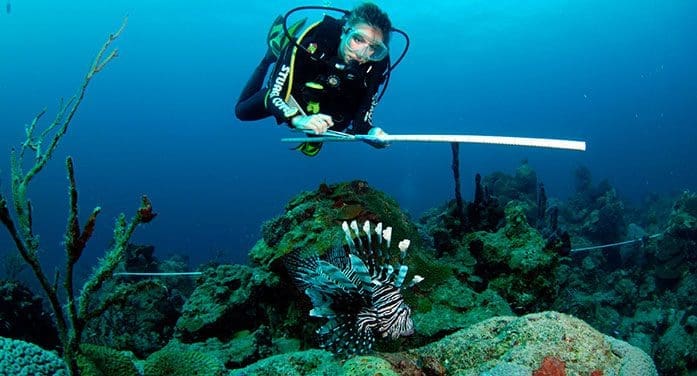
Stephanie Green records observations about a lionfish for her research on invasive species. Green helped create a trait-based tool to predict which native fish may be most vulnerable to the voracious invader. (Photo courtesy Stephanie Green)
It’s not enough to understand what the effects of climate change are. Society needs ways to get ahead of these changes, to predict them before they actually happen. And when it comes to conservation, the approach scientists use to study species in the wild could be critical to these predictions, according to a recent research review led by biologist Stephanie Green.
 Stephanie Green |
 Larry Crowder |
“Environments are changing rapidly in ways that we’ve never seen before. We’re in an unprecedented time of biodiversity exchange,” says Green, an assistant professor in the Department of Biological Sciences at the University of Alberta and Canada Research Chair in Aquatic Global Change Ecology and Conservation.
As Green explains, species are moving into environments where they’ve never been before as their ecosystems change rapidly. Researchers don’t yet have data on what these species may do in these new environments. However, they can gather important information from the traits a particular species has that allows them to make key predictions.
“We’ve come up with a framework for understanding which species are going to go where and what will happen when they do,” says Green.
Green and her team at the University of Alberta, along with collaborators from Stanford University, identified nearly 3,000 traits from a variety of species that “can be used to predict which species will win and lose as ecosystems continue to be affected on our increasingly changing planet.” These traits include body size and shape, how well they can tolerate heat and cold, and how they go about feeding or foraging.
Advances in computing technology and increased research focusing on biodiversity and species traits paved the way for the trait-based lens, Green notes.
“We’ve got this big body of research that shows us what the world looks like right now, but to really come up with solutions and strategies for conservation, we need to look ahead.”
One of the best ways to test the new trait-based lens is to look at ecosystems where rapid change is already happening. Often, these are at the boundary between tropical and temperate climate zones.
Green and her team have two projects underway involving this trait-based approach. In the first, they’re studying albacore tuna on the west coast of North America because this population’s move to different waters could significantly impact fisheries. The other project examines the invasive Indo-Pacific lionfish to gauge the effects they’re likely to have based on their traits.
Study shows most efficient ways to capture invasive lionfish by Michael Brown
Diving at dawn and dusk could save time and money in battle against the voracious predators
Including Indigenous perspectives in conservation planning by Bev Betkowski
How Indigenous and Western knowledge can be equal partners in conservation solutions
“We’ve already seen phenomenal change in our ecosystems with the loss of species and movement of animals into places they’ve never been before. It’s only going to accelerate,” says Larry Crowder, a co-author of the study and professor at Stanford University.
The trait-based lens allows researchers to apply what they already know to make informed predictions of what the consequences may be as species move into these new environments, Green explains.
“We need to be able to anticipate the changes so our conservation and our management is keeping pace with the changes, so we’re not always a few decades behind what the reality is going to be.”
The research was supported by a Lenfest Ocean Program Grant and a Sloan Research Fellowship.
| By Adrianna MacPherson
Adrianna is a reporter with the University of Alberta’s Folio online magazine. The University of Alberta is a Troy Media Editorial Content Provider Partner.
The opinions expressed by our columnists and contributors are theirs alone and do not inherently or expressly reflect the views of our publication.
© Troy Media
Troy Media is an editorial content provider to media outlets and its own hosted community news outlets across Canada.

